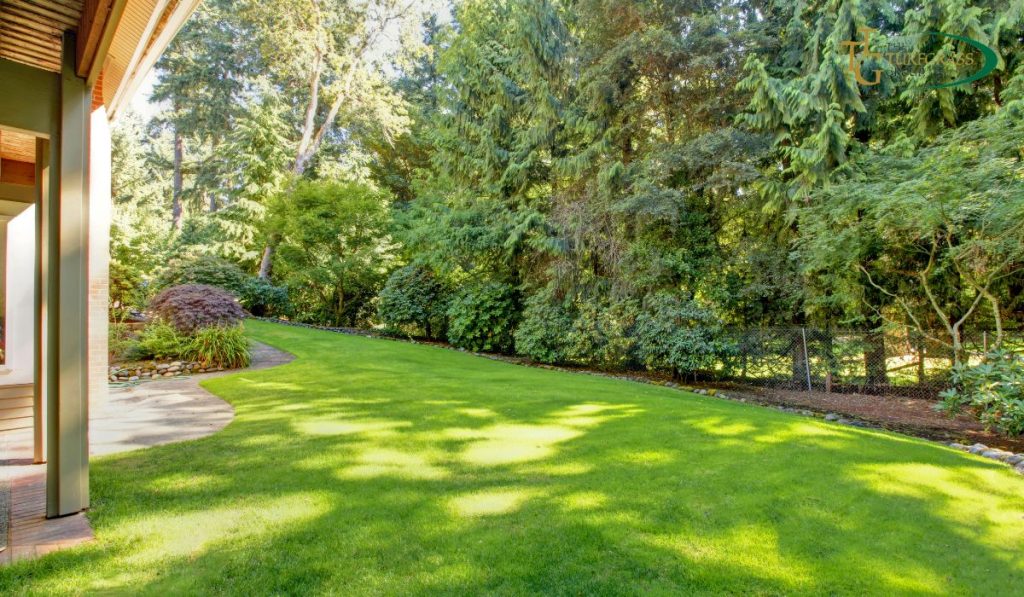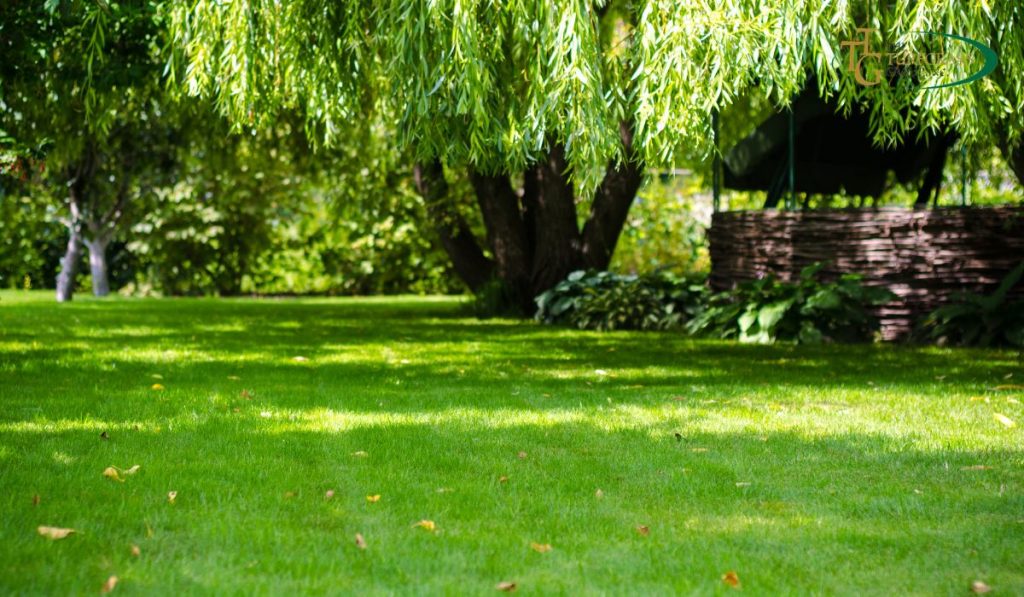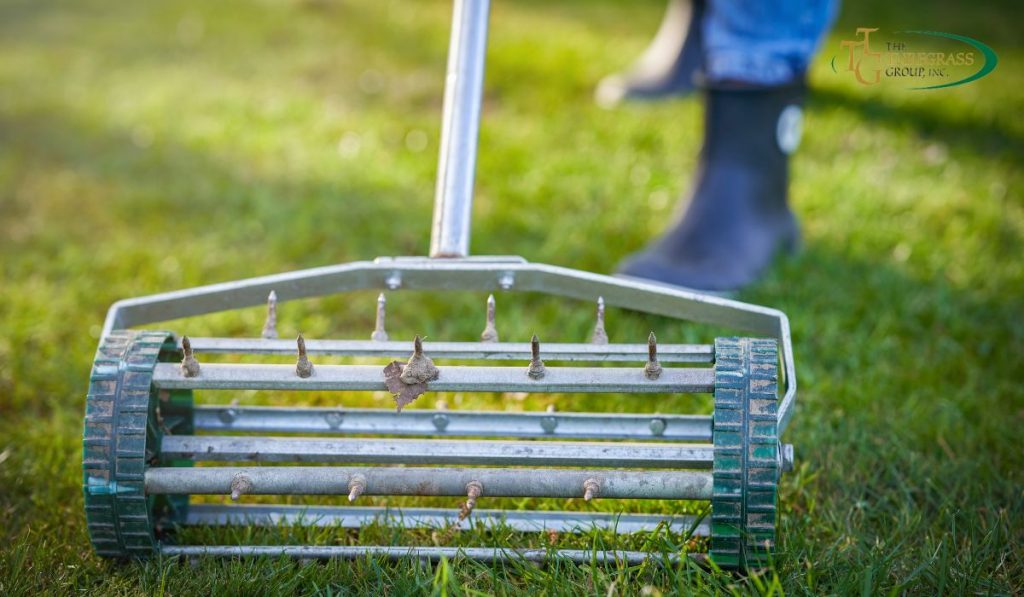
There’s nothing more satisfying than a uniformly green lawn.
No spots, no dead patches, no thinning sections.
It’s the goal of every home lawn enthusiast.
But summer and early fall can be tough on your grass.
Heat, drought, and heavy use can strain your turf, leaving some areas brown or nearly bare.
But with the right approach and cultural practices, you can keep your lawn green all summer and even into the fall.
Here are our top tips to keep your lawn green.
Water Thoughtfully
Improper watering is one of the most common reasons homeowners aren’t getting the lawn they desire.
You can water too much, too little, or at the wrong times.
But getting it right is the best way to keep your lawn green.
How and When to Water
Most established lawns need about one inch of water every week.
That water can come from rain or irrigation.
There is no reason to irrigate your lawn when it has already rained.
So if the weather has been good to your lawn, you can keep the sprinklers off.
But if the weather has been dry and there is no rain, you should irrigate your lawn.
The best way to water your lawn is long, deep, and infrequently.
Giving your soil a good soaking no more than once a week forces your turf’s roots to grow deep and strong to access the water as the soil dries.
On the other hand, frequent and brief irrigation causes roots to spread only in the top few inches of the soil, leading to a weaker plant overall.
The best time to water is in the morning between 4 a.m. and 10 a.m. before the full heat of the day.
Watering early means less water is lost to evaporation, and it gives time for the turf to dry before nightfall.
Watering in the evening or at night leaves grass soggy overnight, which can lead to fungal growth that damages your grass.
Also, avoid irrigating with hot water.
When a garden hose sits in the summer sun, the water inside can get quite hot.
Don’t start irrigating with that water.
Instead, empty your hose after every watering.

If you forget to do that, dump the hot water outside of your lawn and wait for the water to turn cool before you start to irrigate.
Don’t Waste Water
Americans use nearly more than 4 billion gallons of water each day just to water their lawns.
For context, that is four times more water than the entire city of New York.
And much of that water never even reaches the plant roots.
Instead, it is wasted as runoff, which can also pollute natural waterways.
There are several steps you can take to reduce runoff and use your water efficiently.
First, pay attention to your runoff.
If you see water puddling or leaving your lawn before you’ve sprayed one-inch over your lawn, pause your watering.
Give the soil a few minutes to absorb the water and then resume watering.
Also, check how dense your soil is.
Clayey or compacted soil doesn’t absorb water very well and can lead to pooling and runoff without giving the roots adequate hydration.
Aerate your soil once or twice a year to keep it loose and add humus and organic matter to overly clayey or sandy soils.
Loamy soil uses water the most efficiently, so amend your soil before the growing season with that in mind.
A smart irrigation system can also save water.
A digital regulator is attached to your irrigation that monitors weather and soil conditions via WiFi, and the irrigation only turns on as necessary.
Mow Properly
Mowing properly is almost as important as watering properly.
The right mowing techniques can help keep your lawn green.
First, know the proper height for your turf variety.
During the summer, mow at the top end of your turf’s recommended height.
The extra height helps keep the soil cool and reduces evaporation.
Longer blades also bounce back better from foot traffic.
Mowing is potentially stressful for your lawn.
To avoid damaging the plant, never remove more than one-third of its height.
If you let your grass grow too long, you may need to make multiple passes with your mower, setting your mowing deck lower on each pass.
Also, make sure to sharpen your mower blades at least once during the summer.
A dull mower blade can rip the grass, which is much more stressful than a clean cut.
As you mow, it’s best to leave the grass clippings on the lawn.
As the clippings quickly decompose, they return vital moisture and nutrients to the soil.
Also, avoid mowing when the lawn is wet.
Wet grass clippings can clump, and they won’t decompose as quickly.
Clumps of grass clippings can suffocate the grass beneath.
Clean Up After Pets
We love our pets, but we don’t always love what they do to our lawns.
Cat or dog waste isn’t good for your grass, and it can cause dead patches if it isn’t cleaned up.
Ideally, train your pets to relieve themselves away from your lawn.
But if your pet does let loose on your precious turf, you can flush the harmful stuff away with plenty of water.
Pick Up Litter
In addition to pet waste, letting litter sit on your lawn can cause some serious dead patches.
If you have toys, a wading pool, furniture, or other items on your lawn, don’t let them sit on the grass for too long.
Anything sitting on your grass is depriving the plant below it of air, light, and water.
It can also crush the grass blades.
Never leave anything on your grass for too long, and move around items you want to keep in your yard.
Keep Off the Grass
One of the joys of growing a luscious green lawn is using it all summer long.
Running barefoot across your soft grass is a great feeling.
And your turf makes a perfect place for playing, relaxing, or even hosting a party.
But one consequence of all the foot traffic can be thin or bare spots where too many feet have trampled.
So while you want to enjoy your lawn, be mindful of how much stress you put on it.
Give your grass time to recuperate after heavy use.
And never park a vehicle or heavy machinery on your lawn.
Treat Weeds
Keep on top of weeds throughout the summer to prevent an infestation.
If you spot treat weeds with a selective herbicide as you notice them, you can keep your lawn green without too much effort.
If you see a small weed, you may not even need herbicide.
A simple spade and a little digging are often all you need to keep your lawn clear of weeds.
Fertilize Judiciously
If you ask the experts, you may get some conflicting advice on fertilizing.
Many turf professionals recommend just two treatments a year, one in the spring and one in the fall.
Others suggest you should fertilize every six weeks to two months.
The two opinions are not as divergent as they may seem.
The main concern is avoiding over-fertilizing during the peak growth season.
Pushing your grass to grow too quickly can weaken the root and crown.
So if you decide to fertilize during the summer, use a low-nitrogen mix to avoid rapid blade growth at the expense of the other parts of the turf plant.
Pick the Right Turf Type
The health and greenness of your grass throughout the growing season have a lot to do with what type of turf you grow.
Different varieties have advantages that make them more suitable for specific conditions.
Zoysia grass is best for shady areas.

Bermudagrass is an all-around favorite for warm-season grass for hot summers like those in the Southeast.
Research at the University of Georgia has demonstrated that TifTuf™ Bermudagrass, sold exclusively through The Turfgrass Group, greens up sooner, is more drought-tolerant, and stays green longer than other leading bermudagrass varieties.
It also grows rapidly so that it can recover quickly from heavy use.
If you’re interested in the best turf varieties for your lawn, you can find a grower here.
Conclusion
In the pursuit of a lush, green lawn, the journey takes us through various essential steps and practices to ensure its health and vibrancy.
The summer and early fall can be challenging for your grass, with heat, drought, and heavy use taking a toll.
However, armed with the right knowledge and techniques, you can maintain that coveted emerald expanse.
Here are the key takeaways to ensure your lawn remains green and thriving:
FAQs:
How often should I water my lawn during the summer?
During the summer, aim to water your lawn with about one inch of water per week, either through rain or irrigation.
What’s the best time to mow my lawn in the summer?
Mow your lawn in the morning between 4 a.m. and 10 a.m. to reduce water loss due to evaporation and allow the grass to dry before nightfall.
Can I leave grass clippings on my lawn after mowing?
Yes, leaving grass clippings on your lawn can provide moisture and nutrients to the soil as they decompose, benefiting your grass.
How can I prevent pet waste from damaging my lawn?
Train your pets to relieve themselves away from the lawn, and if accidents occur, flush the area with plenty of water to dilute the waste.
Is it necessary to aerate my lawn, and how often should I do it?
Aeration can help improve soil quality. Depending on your soil type, aerate your lawn once or twice a year to keep it healthy.
What’s the ideal turf variety for hot summers?
Bermudagrass, especially varieties like TifTuf™ Bermudagrass, is well-suited for hot summer conditions as it’s drought-tolerant and recovers quickly from heavy use.
Can I use herbicides to control weeds in my lawn?
Yes, selective herbicides can be used to treat weeds in your lawn. Spot treat weeds as you notice them to prevent infestations.
Should I fertilize my lawn during the summer?
Fertilizing during the summer is possible, but use a low-nitrogen mix to avoid rapid blade growth that can weaken the grass.
What’s the impact of heavy foot traffic on my lawn, and how can I mitigate it?
Heavy foot traffic can result in thin or bare spots. Be mindful of usage and give your grass time to recover. Avoid parking vehicles or machinery on your lawn as it can cause significant damage.